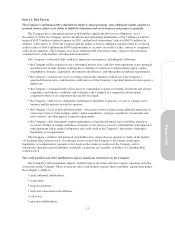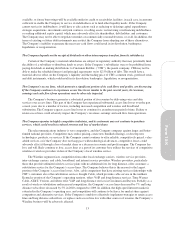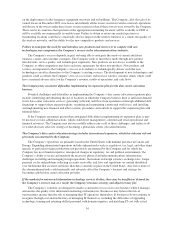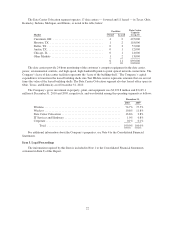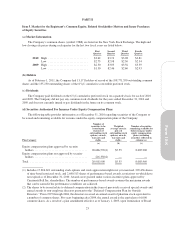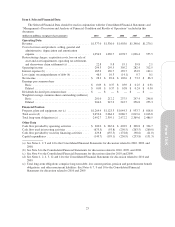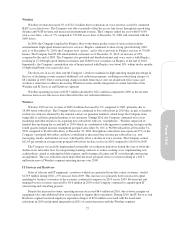Cincinnati Bell 2010 Annual Report Download - page 108
Download and view the complete annual report
Please find page 108 of the 2010 Cincinnati Bell annual report below. You can navigate through the pages in the report by either clicking on the pages listed below, or by using the keyword search tool below to find specific information within the annual report.complete an effective integration of CyrusOne into the Company, anticipated growth in revenue, profitability,
and cash flow resulting from the purchase of CyrusOne could be adversely affected.
The Company’s future cash flows could be adversely affected if it is unable to realize fully its deferred tax
assets.
As of December 31, 2010, the Company had net deferred income taxes of $451.8 million, which are
primarily composed of deferred tax assets associated with U.S. federal net operating loss carryforwards of $385.3
million and state and local net operating loss carryforwards of $60.5 million. The Company has recorded
valuation allowances against deferred tax assets related to certain state and local net operating losses and other
deferred tax assets due to the uncertainty of the Company’s ability to utilize the assets within the statutory
expiration period. For more information concerning the Company’s net operating loss carryforwards, deferred
tax assets, and valuation allowance, see Note 12 to the Consolidated Financial Statements. The use of the
Company’s deferred tax assets enables it to satisfy current and future tax liabilities without the use of the
Company’s cash resources. If the Company is unable for any reason to generate sufficient taxable income to fully
realize its deferred tax assets, or if the use of its net operating loss carryforwards is limited by Internal Revenue
Code Section 382 or similar state statute, the Company’s net income, shareowners’ equity, and future cash flows
could be adversely affected.
A few large customers account for a significant portion of the Company’s revenues and accounts receivable.
The loss or significant reduction in business from one or more of these large customers could cause operating
revenues to decline significantly and have a materially adverse long-term impact on the Company’s business.
The Company has receivables with one large customer that exceeds 10% of the Company’s outstanding
accounts receivable balance. Contracts with customers may not sufficiently reduce the inherent risk that
customers may terminate or fail to renew their relationships with the Company. As a result of customer
concentration, the Company’s results of operations and financial condition could be materially affected if the
Company lost one or more large customers or if services purchased were significantly reduced. If one or more of
the Company’s larger customers were to default on its accounts receivable obligations the Company could be
exposed to potentially significant losses in excess of the provisions established. This could also negatively impact
the available capacity under the accounts receivable facility.
The Company depends on a number of third-party providers, and the loss of, or problems with, one or more of
these providers may impede our growth or cause us to lose customers.
The Company depends on third-party providers to supply products and services. For example, many of the
Company’s information technology functions and call center functions are performed by third-party providers,
network equipment is purchased from and maintained by vendors, and data center space is leased from landlords.
In addition, with the recent sale of the Company-owned wireless towers, almost half of the towers are managed
by a single independent service provider. Any failure on the part of suppliers to provide the contracted services,
additional required services, additional products, or additional leased space could impede the growth of the
Company’s business and cause financial results to suffer.
A failure of back-office information technology systems could adversely affect the Company’s results of
operations and financial condition.
The efficient operation of the Company’s business depends on back-office information technology systems.
The Company relies on back-office information technology systems to effectively manage customer billing,
business data, communications, supply chain, order entry and fulfillment and other business processes. A failure
of the Company’s information technology systems to perform as anticipated could disrupt the Company’s
business and result in a failure to collect accounts receivable, transaction errors, processing inefficiencies, and the
loss of sales and customers, causing the Company’s reputation and results of operations to suffer. In addition,
information technology systems may be vulnerable to damage or interruption from circumstances beyond the
Company’s control, including fire, natural disasters, systems failures, security breaches and viruses. Any such
damage or interruption could have a material adverse effect on the Company’s business.
18





